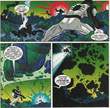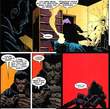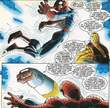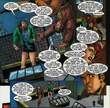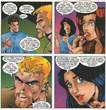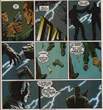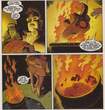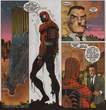Mackie/Byrne Run Review Part 2
In my comprehensive review of John Byrne and Howard Mackie’s Amazing Spider-Man (Vol. 2), I am first looking at the two writers’ individual work on Spider-Man. My primary focus is the role of serialization in these runs. In Mackie/Byrne Run Review Part 1, I discussed Mackie’s solo run on Spider-Man in the late stage of the Clone Saga starring Ben Reilly. Now, I’m analyzing his remaining work on that title following the reinstatement of Peter Parker as Spider-Man.
With Peter back, the Spider-Man line is firing on all cylinders without the baggage of the Clone Saga to weigh it down anymore. Or at least that’s the plan. Post-Ben Reilly Spider-Man is an odd and often ignored period for the character. Remaining on ASM, Tom DeFalco writes street-level, crime-based stories that are mostly unremarkable and bland compared to his material in the 80s. However, Todd Dezago makes up the slack with an incredibly enjoyable, fun Sensational Spider-Man run with Mike Wieringo, and J.M. DeMatteis writes his usual strong, character-driven stories on Spectacular Spider-Man with Luke Ross on art.
However, Peter’s return is not beneficial for Howard Mackie’s Spider-Man. Part of that reason is the freedom the writers gain with the new status quo. Although the titles are not in constant crossovers during the Ben Reilly run, the character dynamics and overarching stories are mainly collaborations between the writers and editors. Story elements like Ben and Peter’s relationship are all planned out by a group of writers, not solely Mackie. Even the issue for which Mackie is best-known, Spider-Man #75, was plotted for months by the editors (and writers too, I assume) of the Spider-Team. In Life of Reilly, a great blog about the Clone Saga, then-assistant editor Glenn Greenberg details how difficult it was to make Mackie follow continuity, and the editors were heavily involved in rewriting the script.
Mostly left to his own devices, Mackie writes Spider-Man (now called Peter Parker: Spider-Man) until the title ends with Spider-Man #98. The most remarkable aspect of this run is how Mackie so seamlessly smashes story genres together. He covers sci-fi, horror/supernatural, kung fu, traditional super-hero, and street level themes in the span of about twenty issues, which is fairly impressive. Yet, the title doesn’t get overwhelmed or cluttered with this frantic genre-jumping. By bringing Spider-Man out of his traditional super-hero stories, Mackie writes some interesting scenarios. In Spider-Man #90, a highlight of the run, Spider-Man is transported to the Negative Zone, where he dons a new costume and leads a rebellion against the tyrant Blastaar all in one issue. In Spider-Man #81, Mackie brings back Cat, a character that mostly occupied Master of Kung Fu until that point, in a light kung fu/street level team-up with Spider-Man.
While he never disappoints in bringing variety to the titles, Mackie often relies too much on clichés in these stories. The aforementioned story with Cat is a cookie cutter kung fu action story, and Spider-Man feels mainly like an accessory to the plot. The stories involving Morbius the Living Vampire have little innovation and feel like they’re pulled directly from early, Gerry Conway-penned plots. There is a typical “new-mutant-is-harassed-by-mutant-haters” story involving the Friends of Humanity at the Empire State University campus. Even with mutant overexposure in the 90s, Mackie could have used this story to offer an interesting commentary on racism or prejudice, but the arc is barely cohesive. The members of the hate group are obnoxiously one-dimensional and the girl they are hunting, Robin Vega, is nothing more than a plot device. Mackie fails to give any of the characters depth, and the Friends of Humanity plot never offers any new commentary. There isn’t any real resolution to the story, as the hate group simply fades away and keeps beating up mutants, as I presume.
The overreliance on clichés really would not be a major problem if the plots were excellent. After all, comic writers like Gerry Conway have made the claim that every story has already been told, and what matters is how a writer tells that story. Mackie is particularly good at managing clichés in his one-shot, Spider-Man: Made Men. He ties together a typical gang crime plot with a fairly generic friendship to make a tragic, interesting story. The street-level plot succeeds due to solid characterizations of the main characters, Tommy and Paul, and the focus on their relationship. Mackie’s script has excellent narrative development with an obvious direction and Ben Urich’s narration as an efficient framing for the events. Crime stories typically rely on clichés, and Mackie manages to spin these clichés into an interesting thread.
Of course, readers must keep in mind that Mackie probably had more time to write Made Men, and it exists as a mostly out-of-continuity, independent entity. When he has to form complex story arcs under time constraints, Mackie’s scripts are lackluster. His main problem is his inability to form cohesive long-term plots and conclusions. During the Clone Saga, he could rely on others to do the heavy lifting with continuity and plotting. He focuses on making his individual scenes good while others deal with putting them in context. In Life of Reilly, Greenberg explains, “Howard Mackie was not much of a ‘continuity’ person. When writing stories that had to deal with or debunk past continuity, Howard tended to give hurried and unsatisfying explanations, or he would simply dance around the matter and quickly move on, hoping that no one would care too much.”
Greenberg’s observation is especially true in The Crown Saga, in which Mackie tries to wrap up three different plot threads in two issues. In this truly ill-considered tale, he attempts to (1) provide backstory and tie up plot threads with mysterious, new hero S.H.O.C. and his enemy, Crown; (2) finish a Morbius plot; and (3) conclude a Hydra-involved crime war. Needless to say, S.H.O.C. never gets enough detail to make the character compelling, and there are many unanswered questions about his powers and origin. The story loses steam and page space when Mackie decides to suddenly switch settings in the middle of the plot. After being captured by Hydra, Spider-Man and S.H.O.C. are recaptured by Hammerhead’s goons for no obvious narrative reason. The long-anticipated mob battle is too quick with an even more expedient finale. Morbius sacrifices himself in a sloppy, half-assed redemption arc when he throws himself at the main villain, Crown, who seems to explode for some reason. The whole story is an utter mess. Another poorly-resolved story element concerns the vampire-bite-induced vertigo that plagues Peter for months in every Spider-Title. After hanging from a building ledge for all of Spider-Man #83 because of the vertigo, Spider-Man realizes he simply has an ear infection. His problems go away speedily with some medication. Clearly, Mackie has problems with his plots and conclusions.
Adding to his plotting issues, Mackie has trouble with hero and villain characterizations throughout this run. While S.H.O.C. shows potential to be a supporting character and ally for Spidey, Mackie keeps his origin and powers vague and confusing, providing little development for his personality. The same goes for his archenemy, Crown and their poorly-defined connection. There is also a half-baked attempt to make the Shocker a more powerful enemy. Mackie tries to convey that the Shocker has been upgraded, but his power levels appear the same as normal. He still shocks Spider-Man, and the hero still shakes it off like he usually does. Further, Shocker’s dialogue completely undermines the effort to make him a respectable villain with winning lines like “I like to think my mother would have been proud of her boy” and “I think I was watching some infomercial about taking charge of the power within … or something like that.” The hardest face palm is spared for Mackie’s sequel to the iconic Nothing Can Stop the Juggernaut story in Spider-Man #84. While Spidey never gives up fighting the X-Men villain in the classic Stern story, he simply lets Juggernaut walk away in the sequel after they fight over a mystical sword of some sort. This story is an insult to the original and its fans, and Spider-Man acts completely out-of-character.
The supporting cast also suffers from poor characterization. Mary Jane has an amazing moment at the beginning of the run in which she stares off a few thugs, but many subsequent scenes consist of her complaining about being too young and whining about Peter being Spider-Man. This is all tired, and Mackie never adds any element to make the typical “MJ is upset” subplot into anything new or interesting. In an interview with Spider-Man Crawlspace following his run, he states, “The marriage allows for far too static a situation for a character who had been around for many years and hopefully will continue to be around for many years to come.” He willingly admits that the marriage is hard for him to write, but this is still strange considering how well he pulled it off during the Clone Saga. The marital dispute is simply a minor annoyance here, but it becomes a larger problem in his run with Byrne.
Also, Mackie’s main additions to the supporting cast, Arthur Stacy, the uncle of Gwen Stacy, and his kids, Jill and Paul, are poorly-developed, aggravating, and confusing. While Arthur could have been an interesting father figure to Peter like his brother, Mackie barely uses him. Jill becomes Mary Jane’s best friend and provides a chance for Peter to reflect on Gwen. However, when Peter talks to her about her cousin, Mackie decides to make a potential touching character moment into a boring, dialogue-lacking montage. Further, Arthur and Jill both have a strange obsession with Spider-Man’s involvement in Gwen’s death. Mackie never elaborates on their relationship with her or provides flashback. Readers never know why they take so long for them to move to New York and investigate her passing. In fact, Mackie never explains how they could even be so close to their cousin if they didn’t even live near Gwen. Adding to the aggravation, when it seems like Mackie is going to have Spider-Man confront Jill or Arthur about Gwen, he leaves the plot at a cliffhanger that is never resolved.
However, Paul Stacy is worse than Jill and Arthur, and he is so repulsive and irritating that he could be Spider-Man’s worst supporting cast member of all time. Mackie uses Paul so often that the reader anticipates character development, but that never comes. Paul is always a lunatic ranting about Gwen and George’s deaths, which occurred around six years ago in comic book time. He blames Spider-Man for killing them and Peter for spending time with them while he couldn’t. He claims George and Gwen were his only friends while he lived on a different continent for years. This irrational anger defines his character, and he refuses to change in any obvious way. While he is in a cringe-worthy conversation with Peter at a club, Paul spews his best line of dialogue: “Don’t you talk to me about my family, Parker! You got to spend time with them! … Time they should have spent with me!” To top it all off, he joins the anti-mutant hate group, the Friends of Humanity. Paul is a truly miserable addition to Peter’s supporting cast that should stay in character limbo.
Part of Mackie’s problem with characterization is his failure with dialogue. I already highlighted Shocker and Paul’s horrible scripting, but every writer has a few bad lines. Therefore, I’ll provide a few more to prove my point. In Spider-Man #76, Crown spews a verbose run-on sentence that makes no real sense: “I, on the other hand, am preparing to present a counter argument with the good doctor’s head if he does not hand over the device he holds in his hands along with every shred of material extrapolated from the late Doctor Fields’ research.” In Spider-Man #79, Doctor Janson sees how many prepositional phrases she can stick on a clumsy expositional recap while sounding completely devoid of emotion: “You want me to find the key to the mysterious blood disorder that has you prowling the night in search of human blood like something out of an Ann Rice novel. … Then, after you turned yourself into this…this…nocturnal creature I began having nightmares in which you played a big role. My shrink bought a summer home on that one.” If someone could explain the grammar behind this line in Spider-Man #90, I would be grateful: “I traveled a long way to rescue guys dressed just like these three kids just dragged off.” For the most part, most of Mackie’s dialogue is not this cringe-worthy, but it is too often that his characters start talking like exposition robots and make the whole script sour.
Without other writers with whom to collaborate, Mackie flounders miserably. He fails to plan out compelling character and plot arcs on his own, and the resulting stories are hard to read. However, the always-persistent 90s crossover machine rears its head for the latter half of Mackie’s Spider-Man, and the story quality unsurprisingly improves. In 1998, the Spider-Office is building towards something big with Norman Osborn and the creative teams are firing on all cylinders. As Mackie demonstrates earlier in Spider-Man #75, one character he can generally write well is Norman Osborn, so he clearly enjoys scripting the villain’s return to Peter’s life. The characters’ conversations are tense, and Mackie knows how to make Norman sound like a true threat. The villain masterfully pushes his enemy’s buttons and exploits his innate heroism. In Spider-Man #88, Osborn jumps off a building so Spider-Man would be obligated to rescue him, torturing the hero for his nobility. Spider-Man #95 features an intriguing situation in which Peter is trapped in an unstable elevator with Norman. Betty Brant and Norman’s grandson, Normie, both of whom are unconscious, are also trapped, and security cameras may or may not be operational. Ultimately, Norman is content stuck behind debris, taunting Peter and obviously relishing in his enemy’s worry over saving them. After retaliating against Norman’s criticisms, Peter decides to take action, saving Normie and Betty. Normie asks Peter if he plans on saving his grandpa, and the hero has no option but to do so. This issue’s dialogue may be too on-the-nose, but this stands as among Mackie’s best.
The more direct crossovers turn out fairly well too. With DeFalco, DeMatteis, and Dezago (the three de’s) for support, these crossovers are fairly solid, probably the best Spider-Man crossovers of the 90s (which sadly isn’t saying much). Mackie’s part in Spider-Hunt is typical 90s action, but at least the issue’s events contribute to a cohesive story. His writing really shines, however, in Identity Crisis. Spider-Man’s use of his newly-acquired Negative Zone grab as an antihero-type character named Dusk is brilliant, probably the best use of an alternate identity during the crossover. Mackie relishes in the tension between Peter’s heroism and his role fraternizing with villains like Trapster. Although Peter goes “dark,” Mackie keeps the character true to himself, making him disgusted by his involvement in the shadowy underworld elements. His guilty conscience compels him to take showers after prowling as Dusk. Further, Mackie successfully ties up plot threads, with which he usually has trouble. Spider-Man convinces Trapster to turn himself in and reveal that he framed Spider-Man for murder at Osborn’s bidding. With this conclusion, Mackie makes Trapster interesting, casting him as a loser that’s been spit out by the criminal system from which he once benefited. The B-list goon realizes that Osborn is a true villain, and Mackie leaves just enough ambiguity to make his choice compelling. Does he turn himself in cowardly for protection from Osborn or heroically in an attempt to put the businessman behind bars? This is the level of storytelling that Mackie loses without a support system, but the creative environment of these crossovers enhances his stories.
That support system helps him, that is, until it suddenly fades away. Post-Identity Crisis, DeFalco and Dezago have a few months to wrap up their individual plot threads and leave. Meanwhile, DeMatteis departs before the Identity Crisis crossover is even over. This has always struck me as an odd switch-up. Why would these writers leave right before the payoff of nearly a year of plot development surrounding Norman Osborn? Especially DeMatteis, who is always so involved with goblins and clearly enjoys writing Norman? It’s possible that these great writers, all of whom contributed to bad crossovers, decided they were involved in enough reputation-damaging Spider-Man work. Nevertheless, what follows is honestly bad enough to rival One More Day as the worst Spider-Man story of all time.
The Gathering of Five is less of a unified crossover as it is a series of mediocre one-shots loosely connected by an odd build-up to a vague spiritual ritual. Todd Dezago delivers two run-of-the-mill issues concerning a creation of his, Override, who joins the ritual in an attempt to save his injured wife. Mackie’s single issue is a clichéd scenario disguised as drama as J. Jonah Jameson contemplates killing Osborn for threatening his family and ultimately decides against murder, surprising no one. What is most interesting is John Byrne’s quiet debut writing Spider-Man in two painfully bland installments. Funnily enough, Spectacular Spider-Man #262 has Mackie’s name on the cover, although Byrne is the writer, and this issue follows Spider-Man as he stops petty crime and young bullies. It feels like a try-out story of a writer dipping their toe in the water to test the temperature, not an essential installment of a major event. His other issue, Amazing Spider-Man #440, reverts the Molten Man to a rampaging monster, diminishing his years of development as a hero. By the end of Gathering of the Five, readers realize that the five haven’t actually gathered, contradicting the story’s title. The most significant development of this story is that Mary Jane leaves college to become a model again, contradicting years of her development as a responsible, rational adult. Getting by on her looks alone foundered earlier (especially after dealing with perverts like Jonathan Caesar), and she entered college to eventually find a stable job. The reversal of development for both Mary Jane and Molten Man foreshadow the damage that Mackie/Byrne cause in the coming years.
While Gathering of the Five is just another mediocre crossover, the Final Chapter is the true beginning of an era of hopeless awfulness. Byrne writes the beginning, in which the actual Gathering of Five happens and five participants try their luck to receive one of five gifts: immortality, wisdom, power, madness, or death. Not only does this odd magical nonsense seem out of place in Spider-Man’s usually street-level adventures, but it makes even less sense in a story intended to end an era of Spider-Man. The ritual’s obvious goal is to act as a catalyst with these five characters, setting them up for future stories. Mattie Franklin and Override resurface during the following relaunch, which surely confused new readers. Nevertheless, this set-up is all Byrne is clearly interested with this story, as he leaves the rest to Mackie.
The Final Chapter is supposed to be the climactic final battle between Spider-Man and the Green Goblin, but it fails to live up to this hype in any conceivable way whatsoever. Spectacular Spider-Man #263 features the startling triumph of Norman Osborn as he kills and unmasks Peter in front of the Daily Bugle. John Romita Jr. beautifully draws the scene and really sells it. That is, until the following issue reveals that is all a delusion in Norman’s head. As it turns out, the villain receives the gift of madness, not power, from the ritual, and Peter defeats him off-panel. Yes, Mackie doesn’t even show the characters’ long-awaited fight. To make matters worse, he introduces the contrived concept of Norman receiving madness thanks to a stupid curse, undermining a year of build-up during which the character was clearly planning something more interesting.
Norman is by no means the only character to suffer from the Final Chapter. In this story’s anticipation, the Spider-Office teases the return of May, Peter and Mary Jane’s child that may or may not be alive and in Norman’s possession. However, Peter finds none other than Aunt May instead, apparently not dead despite Amazing Spider-Man #400. Mackie ruins May’s touching death by revealing that her “passing” was all part of Norman’s elaborate plot to torture Peter. In the most contrived explanation possible, he explains that a genetically modified actress died in May’s place while she has been sitting around in a random house for forty issues. May returns as the perpetually confused old kook that hates Spider-Man again (a retcon of Amazing Spider-Man #200 and Spectacular Spider-Man #188). Once again, she become the damsel in distress when they discover Norman has planted the switch to a DNA bomb in her head. (Another complaint about Norman is he suddenly becomes a genocidal maniac. Why would he ever make a DNA bomb?) May’s return and regression is ultimately unnecessary, considering nobody has any plans for her or seems to want her back.
Ultimately, the most questionable decision is for Peter to give up being Spider-Man yet again. By the time the Final Chapter is published, Peter had so often declared “Spider-Man No More!” that it was a tired trope. Stretching from ASM #18 to most recently Spectacular Spider-Man #229, Peter had constantly tried to give up his hero identity only to return thanks to his strong sense of responsibility. At this point, the plot is lazy and boring as readers must go through the paces waiting for Peter to inevitably become Spider-Man again. Mackie and Byrne don’t even attempt to hide that he will wear the red-and-blue threads again since readers already know about the relaunch as the Final Chapter is published. Ultimately, the decision makes no sense. Another regression, although smaller, concerns J. Jonah Jameson, who becomes a raving lunatic again while Spider-Man prevents the Daily Bugle building from collapsing. In the preceding year, the Spider-Office suggests that Jonah might have an interesting character arc as Norman Osborn takes control of his newspaper and threatens his family. But, he just reverts to the one-dimensional lunatic that lazy writers love. Add him to the characters receiving the reset option in the Final Chapter.
The Gathering of the Five/Final Chapter is a dreadful event that I still generally consider to be worse than even One More Day. While the latter story resets Peter’s marriage, the former does far worse damage, regressing or just plain wrecking the characters of Norman Osborn, Aunt May, J. Jonah Jameson, Mary Jane, the Molten Man, and even Peter Parker himself. In many ways, this single story sets Peter and his supporting cast back at least a decade, and it’s amazing that Mackie and Byrne weren’t even done regressing the character. What makes this story even more unfortunate is that there is real potential for it to be great. Everything involving Norman until this point is fantastic with solid build-up in both his plans and relationship with Peter. This could have been a triumphant story in which Peter saves his child and finally becomes a father. Further, the plotlines with Jonah have potential for him to finally develop as a character, but like most long-running Jonah subplots, this goes nowhere. While the Spider-Man books sets up opportunities for character progression, the Final Chapter totally trashes expectations with little care for fans’ desires.
Like the Clone Saga, this crossover is a clear effort to bring Peter “back to the basics” or at least as close as is possible. Where the Clone Saga seeks to mature Peter, this story goes the opposite direction with the hindsight that a younger replacement simply won’t work. The Spider-Man books essentially reset to the early David Michelinie era, in which Peter and Mary Jane are a young couple with the latter making money as a model. The Spider-Office takes the final step to negate the effects of the Clone Saga and the years following that story, as if the old status quo will reattract the fans that left during the crossover nonsense. In many ways, the Final Chapter is an unapologetic reset button even as Revelations was a reset button only two years earlier. The creative direction of this title is clearly intended to bring Spider-Man back to his past glory after insubstantial sales, and story quality falls to the wayside during frantic restoration. However, the root of the problem still exists: Peter and Mary Jane are still married. The Clone Saga ultimately failed to alleviate editors’ opinions that the marriage made the main character too old for younger fans to enjoy. With that story’s aftermath finally cleared away, the creative team brings their attention back to the marriage. How long will it be until they press the reset button again? How far back will they finally regress Peter? Will they ever be satisfied with how much continuity they have erased? Ultimately, the Final Chapter opens up the Pandora’s box for the regression of Spider-Man serialized adventures. If this story can undo so much progress like a wrecking ball, readers can only fear what might happen next.
Like with most comics of this period, assigning blame is difficult due to editorial influence and writer collaboration. The most obvious culprit is Mackie, but it’s still difficult to point a finger directly at him. After all, he had been writing Spider-Man for nearly a decade prior to this story with little interest in shaking up the status quo. He has always been a writer more interested in writing a cool story with 90s action than in making major decisions about serialization. There is little doubt in my mind that Byrne is involved with this story’s events. Besides his role writing a few chapters, he utilizes the new status quo in the subsequent reboot. Further, the idea of resetting Peter is in-line with Byrne’s overall conservative view of serialized characters. It’s surprising that this story doesn’t simply reboot the character to high school given Byrne’s affinity for the earliest Stan Lee/Steve Ditko/Jack Kirby era of Marvel. Moving farther up the chain of command, editor Ralph Macchio deserves blame for the obvious mandates that he imposed on Mackie and Byrne. In an interview with Spider-Man Crawlspace, Mackie explains that most of the major decisions concerning Aunt May and Peter’s marriage were made by editorial: “The decisions are made above the creative level. These characters are going to be around for a long time. It is foolish to let a writer do whatever they want for brief blip in sales.” Still, even blaming Macchio is difficult due to how involved marketing was in decision-making at the time, especially as Marvel attempted to climb out of bankruptcy.
Honestly, the only element that makes most of Mackie’s post-Clone Saga Spider-Man work readable is John Romita Jr.’s art. Of course, this is Romita’s 90s work, so readers can expect sketchy, blocky figures and angry faces. His Spider-Man is iconic, both thin and muscular in distinctly Spider-Man positions. Particularly, Romita stretches his artistic muscles on Spider-Man #84, in which he draws a second fight between Spidey and the Juggernaut. Fans will have fun comparing his older style, which heavily borrows from his father, in the original Nothing Can Stop the Juggernaut and his more refined, planar style in the sequel. What is obvious is both contain raw energy and brilliant storytelling. Further, Romita’s art works well with Mackie’s penchant for street level stories, and this is clear during Identity Crisis. He uses solid blacks to depict Dusk with minimal details, making the character blend well with shadows and match the darker tone of the story. His layouts on Spider-Man #95 enhance the script by heightening the visual tension between Norman and Peter, resulting in a brilliant double-page spread mirroring their costumed personas. Even his work on the miserable Final Chapter is great, and the scene in which Peter holds the Daily Bugle building from falling is powerful and riveting, even if the scripting makes little sense. Nevertheless, as hard as Romita may try, his art just cannot redeem most of these stories.
Mackie’s post-Clone Saga Spider-Man work consists of mostly inoffensive, poor-quality comics. Character development and cohesive plots take a back seat to mindless action and “badass” moments. Like most 90s comics, these stories are targeted at readers too young to care about anything except crazy fights, blazing guns, and irrational confrontations. The dialogue and story direction are nonsensical, but at least Romita Jr.’s artwork is dynamic. Frankly, if some readers want to turn off their brains and just have a good time reading unabashedly stupid comics, Mackie’s work isn’t bad. Another advantage is this still isn’t as bad as most of Terry Kavanagh’s Spider-Man stories. Some of the later issues are even fairly good. The only point that this run truly becomes unpalatable is the final story, which is just about the worst “final chapter” I could imagine for Spider-Man. Above all, this run proves that Mackie generally fails at managing a monthly title, foreshadowing the catastrophe when he’s partially in charge of the entire Spider-Man franchise. I can only recommend this run to completionists, although they may just want to leave it on the shelf. Overall, I give this 1.5 webs out of 5.
